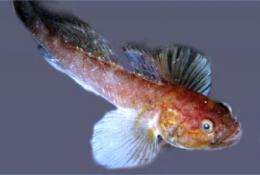Small fish exploits forbidding environment

Jellyfish moved into the oceans off the coast of southwest Africa when the sardine population crashed. Now another small fish is living in the oxygen-depleted zone part-time and turning the once ecologically dead-end jellyfish into dinner, according to an international team of scientists.
"Originally there were sardines in the area but over fishing caused the sardine population to collapse in the 1960s and 1970s," said Victoria A. Braithwaite, professor of fisheries and biology, Penn State. "The sardines never recovered and jellyfish became a huge and serious problem, eating what the sardines had eaten."
Jellyfish are considered a dead end food source because, while they eat lots of small fish and other sea creatures, they have few predators. However, the research team found that the bearded goby, Sufflogobius bibarbatus, a 4-to-6-inch long, 1.5 inch-wide fish, eats jellyfish. Larger fish like hake and mackerel, sea mammals like sea lions and porpoises, and sea birds, like gannets and gulls, eat gobies, putting jellyfish back into the food cycle.
"We don't know if they are eating dead jellyfish from the bottom, or if they are coming up to oxygen-filled layers to eat jellyfish, but they are eating jellyfish," said Braithwaite.
Even stranger than a jellyfish diet is the gobies' use of the dead zone in the area. One reason there were so many sardines and now so many jellyfish is a large area of up-welling water off the southwest coast of Africa from Namibia to South Africa. This deep cold water brings with it large amounts of nutrients. When plankton voraciously eat the nutrients, their populations increase massively. Excess nutrients and dead plankton then fall to the ocean floor.
"A horrible toxic sludge forms, and very few things can live in it except for some bacteria and nematodes," said Braithwaite. "Somehow the gobies can withstand the toxic environment, but we don't know exactly how they are doing it."
Remarkably, the gobies cope without oxygen for hours at a time while they rest on the muddy seabed but remain alert.
"When we touch them with a rod, they show rapid escape responses," said Braithwaite.
Gobies can stay in the anoxic or oxygen-depleted area for at least 10 to 12 hours at a time. The researchers suggest they may be able to remain there even longer. The mud is not just lacking oxygen, but the bacteria that live there use sulfur for energy and produce high levels of hydrogen sulfide, a toxic gas. The researchers report the results of their study in today's (July) 16 issue of Science.
"Normally, other animals cope with anoxia by anaerobic respiration, which causes a build up in lactate," said Braithwaite. "But something else is going on in these gobies as the lactate build up declines after an hour or so without oxygen. Our next step is to look to see what they are doing to cope with anoxia."
For the goby, the anoxic, toxic mud is a perfect hiding place because no predators are willing to enter that environment. The gobies, however, are happy fish in the mud.
"It is a win-win situation where the gobies are using a resource that is usually a dead end in the ocean, the jellyfish," said Braithwaite. "And they are using the toxic mud as a refuge. Together this seems to explain why their population is growing despite the fact that they are now being the main prey species in this unusual ecosystem."
Provided by Pennsylvania State University

















